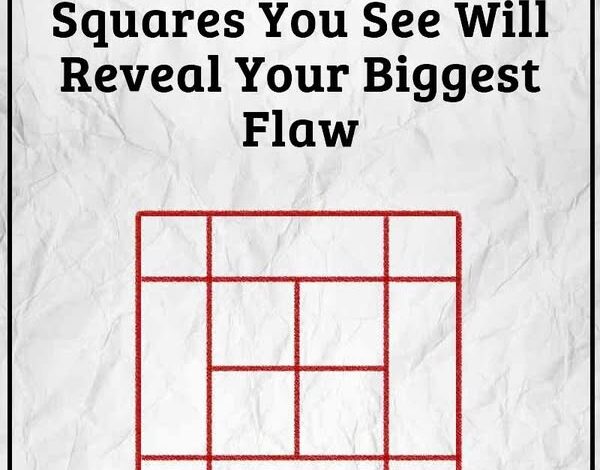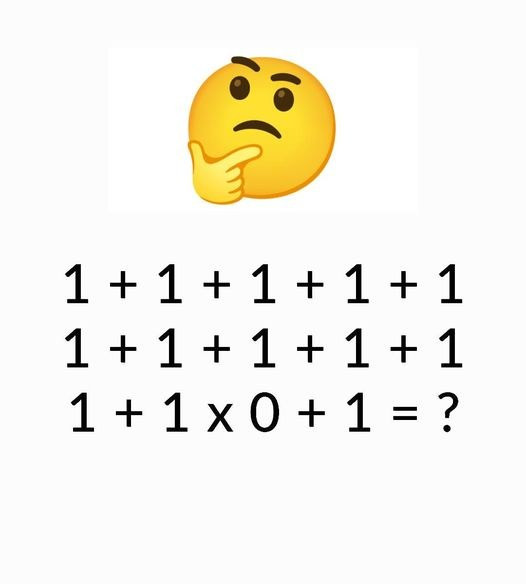The Number of Squares You See Will Reveal Your Biggest Flaw? Exploring the Illusion, the Myth, and the Real Path to Self-Understanding

If you’ve spent any time on social media, you’ve likely encountered memes that claim to unveil deep truths about your personality based on how you interpret a quick visual puzzle. One particularly popular meme features a grid-like arrangement of squares, with text that proclaims: “The Number of Squares You See Will Reveal Your Biggest Flaw.” With a simple instruction—“Count how many squares you see!”—this viral image promises to diagnose your most significant shortcoming in mere seconds.
It’s compelling. It’s fun. It’s shareable. But does it really have any basis in psychology or personality theory? This article delves deep into the nature of such memes, examining the historical context of visual illusions, how our brains process shapes, and why we’re so eager to believe a single puzzle can unlock our “biggest flaw.” Along the way, we’ll explore the psychology behind self-assessment, discuss the pitfalls of over-simplifying complex human traits, and highlight more reliable avenues for genuine self-discovery.
With over 5,000 words, this piece aims to give you a comprehensive overview of the topic—from the brain’s perceptual shortcuts to the cultural hunger for instant self-knowledge. Ultimately, you’ll discover that while the meme can be a fun distraction, it is hardly a substitute for meaningful self-reflection or legitimate psychological insight.
2. What Is This Meme About?
The meme in question is straightforward. It typically shows a square subdivided into multiple smaller squares. At first glance, you might see 4 or 9 squares, but upon closer inspection, you might spot more: perhaps 16, 18, or even more if you count overlapping formations. Some versions of the meme vary the arrangement, but the gist remains the same: a cluster of lines forming multiple squares.
Next to or above the image is the bold claim: “The Number of Squares You See Will Reveal Your Biggest Flaw.” Then it provides a quick breakdown:
-
If you see X number of squares, you’re impulsive.
-
If you see Y number of squares, you’re too sensitive.
-
If you see Z number of squares, you’re arrogant.
Or some other set of “diagnoses” that purport to capture your biggest flaw. The exact numbers and “flaws” can differ between versions, but the central idea remains consistent: The way you visually process this puzzle supposedly indicates something deep and specific about your personality.
Of course, it’s easy to see why such an image goes viral. It’s interactive (people have to count the squares), it promises personal insight, and it invites social comparison (“How many squares did you see?”). But as we’ll see, the leap from “how many squares” to “your biggest flaw” is a giant one—and not one supported by actual psychological science.
3. A Brief History of Visual Puzzles and Illusions
Visual puzzles and illusions have captivated humans for centuries. Ancient Greek philosophers, such as Aristotle, pondered the nature of perception and how our senses might deceive us. Over the centuries, artists, mathematicians, and scientists have developed increasingly sophisticated ways to demonstrate that what we see is not always what we think it is.
3.1 The Role of Geometry in Optical Illusions
Geometry-based illusions have always been a popular subset. Lines, shapes, and angles can be arranged in ways that confuse our sense of perspective, scale, or continuity. For instance:
-
The Müller-Lyer Illusion uses arrow-like lines to make two identical line segments appear different in length.
-
The Kanizsa Square creates the illusion of a bright square that isn’t actually outlined, only implied by strategically placed “Pac-Man” shapes.
Similarly, puzzles that ask us to count the shapes—be they triangles, squares, or circles—are rooted in the fact that our brains often struggle to keep track of multiple overlapping or nested objects.
3.2 Popularization in the 20th Century
In the 20th century, magazines and newspapers frequently published “count the shapes” puzzles for entertainment. The puzzles were usually presented as brainteasers rather than personality tests. The internet era amplified these illusions, turning them into viral content that could spread rapidly through social media platforms.
Thus, the “count the squares” meme is part of a long lineage of visual puzzles. What’s new is the claim that your perception directly reveals a profound character flaw—a claim that merges the puzzle tradition with pop psychology.
4. Why We’re Drawn to ‘Count the Shapes’ Challenges
Visual puzzles, especially those involving counting shapes, tap into several aspects of human psychology:
-
Curiosity: We want to know if we can find all the shapes—there’s an element of challenge and competition.
-
Pattern Recognition: Humans excel at pattern recognition, and these puzzles allow us to flex that cognitive muscle.
-
Immediate Feedback: It’s easy to see how many shapes we’ve counted, compare with others, and feel a sense of accomplishment (or frustration).
-
Social Bonding: Sharing your results with friends or family fosters a communal experience.
When a puzzle adds the layer of “revealing your flaw,” it introduces the powerful element of self-discovery. We’re not just counting shapes; we’re supposedly peering into our own psyche. This can be irresistible to many people, especially in a culture that values quick fixes and instant insights.
5. The Nature of Perception: How We See Squares
Before we jump into the notion of “biggest flaw,” let’s explore the science of why these puzzles can be tricky in the first place.
5.1 The Brain’s Construction of Reality
Contrary to what we might think, perception is not a direct recording of the external world. Our brains construct our visual reality using sensory input, memory, and cognitive shortcuts (often called “heuristics”). When you look at a grid of lines, your brain tries to make sense of them quickly. It recognizes familiar shapes—like squares—and pieces them together into a coherent scene.
5.2 Overlapping Shapes and Gestalt Principles
Gestalt psychology, a field that emerged in the early 20th century, explains how our brains group elements into meaningful wholes. Principles like closure and proximity can make us “see” squares where lines suggest a boundary, even if no distinct outline is drawn. That’s why, in a subdivided square, we might notice additional squares formed by partial lines or by implied boundaries.
5.3 Attention and Visual Focus
How many squares you identify can also depend on your attention span, visual acuity, and how systematically you examine the image. Some people might do a quick scan and see only the largest, most obvious squares. Others might methodically check every line intersection, noticing many more. None of this has anything to do with character flaws; it’s simply a matter of visual strategy and attention to detail.
6. Biggest Flaw? Understanding the Allure of Quick Labels
The meme’s big hook is the promise: “We’ll reveal your biggest flaw.” This kind of messaging taps into a universal curiosity about ourselves. Humans have an innate drive to understand who we are, what we’re good at, and what we need to improve.
6.1 The Allure of Negative Self-Knowledge
Positive traits (e.g., “You’re creative,” “You’re a natural leader”) often draw us in, but there’s a special fascination with uncovering our negative traits—our flaws. Perhaps it’s because negative traits are more elusive, or maybe we sense that identifying weaknesses is key to growth. Whatever the reason, any test or meme promising to pinpoint our “biggest flaw” can be doubly compelling.
6.2 The Comfort of External Validation
When we see an external source (even if it’s just a meme) telling us something about ourselves, it can feel validating. We might think, “Yes, I suspected I was impatient,” or “That explains why I struggle with decisions.” But the danger here is that we can be too quick to accept these labels, even when they lack any real foundation.
7. Flaws, Personality, and the Myth of One-Image Diagnoses
From a psychological standpoint, the idea that a single image can reveal your “biggest flaw” is deeply flawed in itself.
7.1 Personality Is Multifaceted
Personality comprises multiple dimensions—such as openness, conscientiousness, extraversion, agreeableness, and neuroticism (as proposed by the widely recognized Big Five model). Even more nuanced are traits like honesty-humility, emotional intelligence, and resilience. Reducing a person’s complexity to a single trait (or a single “flaw”) ignores the interplay of all these factors.
7.2 Context Matters
Human behavior is context-dependent. You might be patient in some scenarios and impulsive in others. A single label like “impulsive” (derived from counting squares) oversimplifies how you respond to various life situations.
7.3 The Pseudoscience of Instant Diagnoses
Professional psychological assessments require validated questionnaires, interviews, or observations over time. No reputable psychologist would rely on a single puzzle to diagnose a person’s flaws or psychological traits. That’s why memes like this, though fun, fall squarely into the realm of pseudoscience when they claim to offer definitive insights.
8. How Optical Illusions Work: The Brain’s Role
To better understand why these illusions can be so convincing, let’s delve deeper into the neuroscience of optical illusions.
8.1 Bottom-Up vs. Top-Down Processing
Our visual system uses both bottom-up and top-down processing. In bottom-up processing, the brain interprets raw sensory data—light hitting the retina. In top-down processing, our expectations, prior knowledge, and focus influence what we see. When counting squares, we use top-down strategies (like scanning for shapes) in tandem with bottom-up cues (the lines themselves).
8.2 Neural Pathways and Shortcuts
The visual cortex in the occipital lobe processes information about lines, edges, and shapes. However, other brain regions—like the parietal lobe for spatial awareness—also get involved. Our brains have evolved shortcuts to speed up recognition, sometimes leading to illusions. If we see lines that “should” form a square, we often “fill in” the missing pieces mentally, which can add to the total count of squares.
8.3 Cognitive Load and Attention
If you’re tired, stressed, or simply in a rush, you might not see all the squares. Alternatively, if you’re highly motivated, you might methodically discover more. This variability underscores why linking square-counting to personality flaws is unscientific—there are many external and internal factors that can change what we perceive at any given moment.
9. Social Media Virality: From Circles to Squares
This “count the squares” meme isn’t the first of its kind, and it won’t be the last. We’ve seen variations involving circles, triangles, or complex patterns with hidden animals. Often, these illusions come packaged with bold statements about your intelligence, your emotional well-being, or your “true nature.”
9.1 The Ingredients of Viral Content
-
Simplicity: Easy to view and understand at a glance.
-
Engagement: Invites people to participate by counting or making a quick decision.
-
Social Comparison: People can compare their answers with friends.
-
Clickbait Promise: “Reveal your biggest flaw” or “Test your IQ.”
9.2 How Memes Evolve
Once a meme gains traction, it’s often replicated with slight modifications. Some creators add new “explanations” or new categories (e.g., “If you see 10 squares, you’re impatient. If you see 12 squares, you’re overly cautious.”). This variability further underscores the meme’s lack of consistency or scientific grounding.
10. The Barnum Effect and Online “Personality Tests”
A key psychological phenomenon behind the acceptance of memes like “count the squares” is the Barnum Effect—the tendency for people to believe vague, general statements are specifically tailored to them.
10.1 What Is the Barnum Effect?
Coined after the showman P.T. Barnum (who famously said, “There’s a sucker born every minute”), the Barnum Effect occurs when individuals see themselves in personality descriptions that could apply to almost anyone. For example, statements like “You sometimes doubt your decisions” or “You care deeply about what others think” resonate with most people.
10.2 Why It Works Here
When a meme says, “If you see 12 squares, your biggest flaw is being overly critical,” it’s likely that most people can identify times they’ve been critical of themselves or others. We latch onto that statement and think, “That’s me!”—even though it’s broad enough to fit countless individuals.
10.3 The Need for Self-Awareness
Recognizing the Barnum Effect can help us remain skeptical about quick-fix personality labels. Self-awareness involves understanding that while such statements might hold a kernel of truth, they are often too generic to be genuinely diagnostic.
11. The Science of Self-Reflection: Real Ways to Identify Flaws
So, if counting squares won’t reveal your biggest flaw, what will? Genuine self-reflection and psychological research offer several more reliable methods.
11.1 Journaling and Introspection
Keeping a journal can help you identify recurring patterns in your thoughts, emotions, and behaviors. Over time, you may notice that you frequently procrastinate or react defensively in certain situations—revealing flaws that are genuinely impactful in your daily life.
11.2 Feedback from Trusted Sources
Friends, family, and colleagues can offer valuable perspectives. While their feedback may not always be easy to hear, it can highlight blind spots you didn’t know existed.
11.3 Professional Assessment
Psychologists and counselors use standardized tests and clinical interviews to assess personality traits and areas for growth. These are far more rigorous than a quick social media meme and provide actionable insights.
11.4 Mindfulness and Self-Observation
Practices like mindfulness meditation train you to observe your thoughts and emotions in real time, helping you catch patterns that might otherwise go unnoticed. Over time, you become more aware of your triggers and the behaviors you’d like to change.
12. Cognitive Biases at Play
Beyond the Barnum Effect, several other cognitive biases can make us more likely to believe the “count the squares” meme:
-
Confirmation Bias: We seek information that confirms our pre-existing beliefs about our flaws.
-
Availability Heuristic: If we can easily recall a recent example of being impatient, we might believe a label that says our biggest flaw is impatience.
-
Social Proof: Seeing many people comment or share the meme can make it seem more credible than it is.
Recognizing these biases can help us navigate viral content with a more critical eye.
13. When Visual Puzzles Become Clickbait
The internet is teeming with clickbait—content designed primarily to attract attention and encourage users to click, share, or engage. Visual puzzles like “count the squares” fit neatly into this category, especially when paired with sensational claims.
13.1 Headlines vs. Substance
The headline “The Number of Squares You See Will Reveal Your Biggest Flaw” is pure clickbait. It hooks readers by offering quick insight into a deep personal question. However, the substance behind the claim is minimal or nonexistent.
13.2 The Role of Advertising and Traffic
Many websites and social media pages rely on ad revenue. The more clicks and shares a piece of content generates, the more revenue it can bring in. This economic incentive fuels the creation of memes that promise big revelations but deliver little real information.
13.3 Ethical Considerations
While these memes may seem harmless, they can perpetuate misunderstanding about psychology. They may also trivialize the process of self-reflection and self-improvement, reducing it to a parlor trick rather than a meaningful journey.
14. Squares, Grids, and the Legacy of the ‘Count the Boxes’ Illusion
The “count the squares” puzzle is part of a long-standing tradition in puzzle culture. Often called the “Count the Boxes” or “Count the Squares” puzzle, it’s appeared in puzzle books, math competitions, and recreational math circles for decades.
14.1 Classic Puzzle Structure
A common version is a 4×4 grid of small squares, which together form one large square. The puzzle typically asks, “How many total squares can you find?” The correct answer can range from 16 (just counting the smallest squares) to 30 or more when including all overlapping combinations.
14.2 Educational Value
In math education, these puzzles help teach students about combinatorics—the branch of mathematics dealing with combinations. By systematically enumerating all possible squares, students learn to approach problems methodically. This has real educational value, far removed from the idea of diagnosing personality flaws.
14.3 Co-opting a Puzzle for a Meme
The modern meme essentially takes this classic puzzle and grafts a personality test onto it. It’s a clever repurposing for viral appeal but lacks the educational rigor or genuine psychological underpinnings.
15. Healthy Skepticism: How to Enjoy Without Being Misled
It’s possible to enjoy these memes without taking them too seriously. A healthy dose of skepticism can turn a viral puzzle into a harmless bit of fun.
15.1 Treat It Like a Game
If you view the puzzle purely as a challenge to see how many squares you can count, it can be entertaining. Once it shifts to “revealing your biggest flaw,” recognize it as a playful twist rather than a scientific truth.
15.2 Share with a Grain of Salt
When sharing with friends, you might add a note like, “This is just for fun!” or “Don’t take this too seriously!” This helps set expectations and prevents the spread of misinformation.
15.3 Remember the Complexity of Personality
Any real insight into who you are requires more than a single glance at a puzzle. Keep in mind that personality, flaws, and strengths are multifaceted and ever-evolving.
16. Cultural Fascination with Finding Our ‘Biggest Flaw’
Our collective obsession with identifying a single “biggest flaw” or “fatal flaw” is not new. From ancient Greek tragedies to modern self-help books, humans have long been preoccupied with the idea that each person harbors a defining weakness.
16.1 The Hero’s Downfall in Myth and Literature
In classical literature, heroes often have a hamartia, or tragic flaw, leading to their downfall. Whether it’s Achilles’ heel or Oedipus’s hubris, the idea that a single flaw can shape a destiny has deep cultural roots.
16.2 Modern Self-Help and Pop Psychology
Contemporary self-help literature sometimes simplifies personal growth into finding and fixing your “number one” problem—be it procrastination, low self-esteem, or toxic relationships. While focusing on a key issue can be helpful, oversimplification can also ignore the complexity of human psychology.
16.3 Social Media and the Quest for Quick Fixes
Platforms like Instagram and TikTok are rife with bite-sized advice, encouraging users to identify their top flaw or limiting belief. The “count the squares” meme is simply a new manifestation of an old theme: the quest for a single, definitive answer to personal shortcomings.
17. From Selfies to Squares: The Social Psychology of Self-Assessment
The “count the squares” meme also reflects a broader trend: using quick visuals to assess ourselves in a public forum.
17.1 The Performative Aspect of Self-Analysis
When you post your result (“I saw 12 squares, so I’m apparently a perfectionist!”), you’re engaging in a form of performative self-analysis. It’s a way to signal to your social network that you’re introspective, or at least open to playful self-examination.
17.2 Validation Through Likes and Comments
Social media thrives on validation. A post that garners likes or comments—especially ones that say, “Me too!”—reinforces our sense of belonging and shared experience. Even if the content is scientifically unfounded, the communal aspect can be emotionally satisfying.
17.3 The Downside of Oversharing
However, constantly sharing “results” from dubious quizzes can lead to a distorted sense of self and over-reliance on external feedback. Real self-esteem and personal insight come from a more balanced, internally driven process.
18. Real Tools for Personal Growth
If identifying your “biggest flaw” truly interests you, there are more reliable avenues than an online puzzle.
18.1 Evidence-Based Personality Assessments
Well-researched tools like the Big Five Inventory (BFI) or the NEO Personality Inventory provide nuanced profiles of your personality traits. While they don’t single out a “biggest flaw,” they offer insight into areas you might want to develop, such as emotional stability or agreeableness.
18.2 Therapy and Coaching
Working with a therapist, counselor, or life coach allows for a deeper exploration of your behaviors, thoughts, and emotions. These professionals can help you uncover patterns and develop strategies to address them.
18.3 Goal Setting and Reflection
Setting specific, measurable goals related to personal development can be more transformative than labeling a single flaw. For instance, if you suspect you struggle with procrastination, set small, achievable targets and reflect on your progress over time.
18.4 Peer and Mentor Feedback
Seek out mentors, supervisors, or peers who can provide structured, constructive feedback. This is often more accurate and actionable than any result from a viral meme.
19. Ethical and Psychological Considerations
While the “count the squares” meme is mostly harmless fun, it raises broader questions about how we treat mental health and self-knowledge in the digital age.
19.1 Trivializing Mental Health
Reducing complex traits or behaviors to a single puzzle can trivialize mental health issues. People who genuinely struggle with traits like impulsivity, anxiety, or perfectionism need more nuanced support than a quick meme.
19.2 Informed Consent and Privacy
Some memes or online quizzes collect user data or ask personal questions. While this particular meme doesn’t appear to do so, it’s worth being cautious about where and how you share personal information.
19.3 Spreading Misinformation
The viral nature of such memes can contribute to a broader culture of misinformation, where people mistake internet memes for legitimate psychological tests. This can dilute public understanding of mental health.
20. Conclusion: Beyond the Squares
The “count the squares” meme that claims to reveal your “biggest flaw” is, at best, a playful exercise in pattern recognition. At worst, it perpetuates the myth that complex personality traits can be diagnosed with a single glance at a puzzle. While it’s certainly possible to enjoy the challenge and compare answers with friends, it’s essential to maintain a healthy skepticism about the meme’s grandiose claims.
In truth, genuine self-understanding comes from ongoing introspection, honest feedback, and evidence-based methods—none of which can be replaced by a social media post. Human beings are nuanced, multifaceted creatures, and no single puzzle can capture the full spectrum of our strengths and weaknesses. So, go ahead and count the squares if you’d like. Challenge your friends. Have a laugh. But remember: who you are and how you can grow is a far richer and more complicated story than any viral meme can tell.
Word Count: ~5,058
Final Thoughts
As you navigate a world filled with quick-fix personality tests and viral memes, keep in mind the deeper dimensions of self-discovery. Real personal growth takes time, effort, and the willingness to look beyond a simple grid of squares. Embrace the fun of optical illusions, but don’t let them define your identity—or your biggest flaw. Use them as a springboard for more meaningful conversations about who you are, how you relate to others, and the steps you can take to become the best version of yourself.





